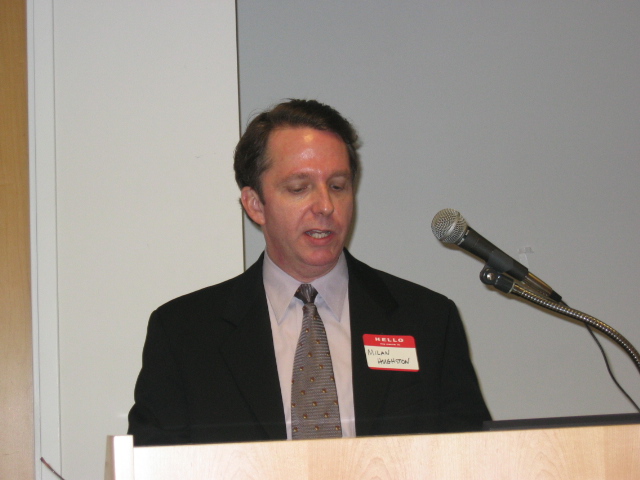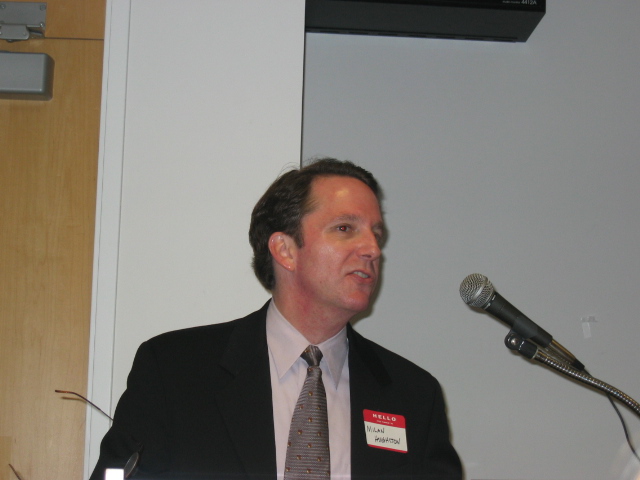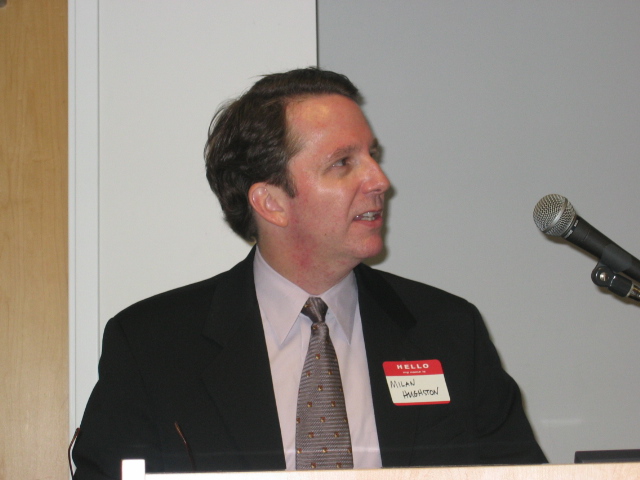Ninth Annual New Jersey Book Arts Symposium
Styles of Collecting, Styles of the Book
Morning Panel: Milan Hughston
Milan Hughston, (Director of the Library of the Museum of Modern Art), divided his talk between recounting of local history and a slide history of artists' books. He began by alluding to the MoMA construction project that will see the museum return to Manhattan in November, 2004 and the library and study center open a year hence, in November, 2005. Involvement in designing the new library space has absorbed his time and allowed little room for collection development, he confessed, although he has been learning what makes an artists' book. (Mr. Hughston would illustrate his conceptual work by offering several definitions of artists' books throughout his talk and slide presentation.) Mr. Hughston's brief history of the development of the artists' book collections at MoMA began with the acquisitions of Alfred Barr and Monroe Wheeler, noted that a seminal point occurred with the acquisition of the Louis Stern Collection (which, sidebar comment, connects MoMA to the Rutgers art library collections), and came into sharp focus under the direction of Clive Philpott. He repeated Martha Wilson's comment, that obtaining artists' books was easy, caring for them was the hard part, one of the reasons she helped to sell the Franklin Furnace collection to MoMA in 1993. Mr. Hughston concluded the sketch by saying that the artists' book collection currently totalled over 12,000 titles, then turned his attention to a discussion of Clive Philpott's collecting policy statement, which continues to guide museum collecting to this day. While building the MoMA collection Philpott hadn't worked with a written policy, but with his departure felt obligated to write one. First of all, he had expressed discomfort with the term "artists' book," since it struck him as too broad and inclusive, serving to define objects with very little in common. Mr. Hughston ran down all of Philpott's criteria with little comment, including the famously controversial item that an artists' book must be part of an edition of 100 copies or more. In addition, he remarked that researchers tend to want to look at books by particular artists rather than books on a particular theme or employing a particular technique (referring back to Dr. WOo's principles of collection organization). He rightfully took pride in noting that the entire collection was under bibliographic control. While it was very unfortunate that the length of the presentations--elongated by the complexity of coordinating different a/v aids--precluded any sustained q. and a., it was particularly unfortunate not to have time to discuss the next point Mr. Hughston raised. He reported having just seen a kind of book for which he hadn't a definition, at the recent print fair. This kind of book reflects an artists' work, but is not considered an artists' book. His print curators wouldn't buy this kind of book, yet at a cost of $300 per copy, the library couldn't itself afford to collect it comprehensively, either. MoMA "needs to acquire" these books, he said, "but where do they go?" It would have been worthwhile indeed for the audience members, many of whom were private and institutional collectors themselves, to collectively ponder this perplexing question. MIn his brief glimpse of some of the highpoints of the early history of artists' books, Mr. Hughston showed slides of the orignary work of Ed Ruscha, Lawrence Weiner, Dieter Roth, and Sol Lewitt, among others, and provided a definition of an artists' book that sounded a wry note: artists books are "books which do not cost as much as prints." During the changeover from informal history to slideshow, a technology complication allowed for some questions--one of which resonated the point Dr. Woo's presentation had raised, concerning the dynamic tension between institutional guidelines and curatorial expression:
Q: "I'm hearing that books published in an edition of less than 100 are important . . .."
A: "Well, we violate that rule a lot.
Of course, that MoMA continues to take the book seriously as an artistic medium there is no doubt, as is demonstrated by its web exhibition of the art of New Jersey born artist, Kiki Smith (Prints, Books and Things [Wayback Machine]). Following Milan Hughston, Marshal Weber, an artist and a director of the collective, Booklyn Artists' Alliance, gave a web-presentation of the Booklyn website, which reflects his own tastes and sensibilities. His talk included insightful remarks on a variety of economic and political issues of concern to artists, and made a brilliant case for the value of artist collectives like Booklyn to artists producing book art.



